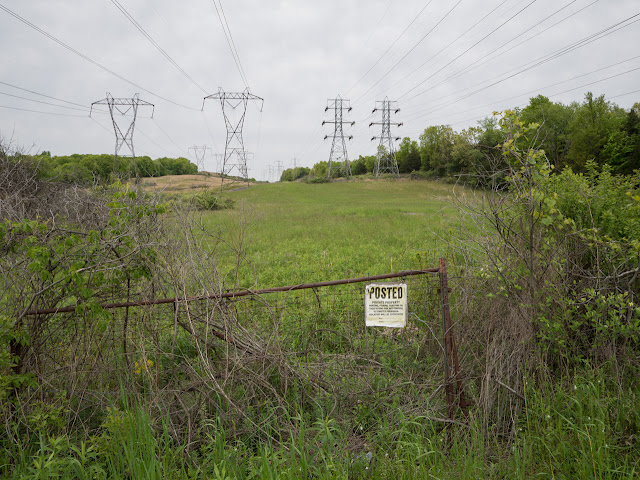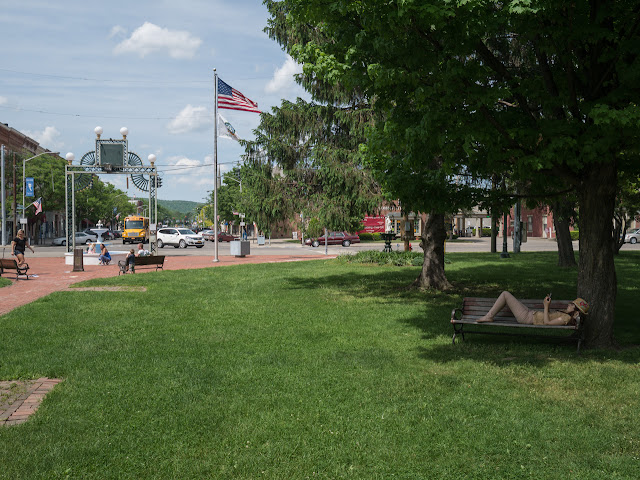Southington, Connecticut
Thursday, June 30, 2016
Wednesday, June 29, 2016
Simple Solutions
Woodbury, Connecticut
That's a snap from January in one of the ultra-modern, clean-room level work spaces, at the Working Pictures World Headquarters. What's happening here is making a "digital proof" of a 12x20 inch negative.
The problem with a big archive of large (and ultra-large) format negatives is getting a look at the pictures in positive form. David Vestal many years ago said something close to, "when it comes to judging a picture by looking at the negative, there are two camps; those who think they can, and those who know they can't." To make silver proof prints would cost a fortune and take forever. Scanning the negs costs nothing if you've already got a scanner, but even at low, screen-viewing resolution, it takes forever. Plus, my scanner can't handle my biggest negatives, at all. The simple answer is to put the negs on my old Logan 24" slide viewer with some loose chipboard masks and copy them with a semi-retired digital camera, one of my Lumix G3s. Smaller negs get shot with a 45mm, big ones with a 25.
Compared to scanning, this is lightening fast. I found I could capture a batch of negatives—remove the last neg from the unit, position the next one, actuate the camera, adjust the live histogram, expose. Repeat, at well under one minute each. Then, after downloading to the computer, use the Edit feature in Bridge, select the new files and use a custom setting to invert and convert them to rgb grayscale. Boom, a whole folder of legible positive transcriptions of the negatives. I began doing this at least fifteen years ago, with an early Fuji digicam before I had a "real" digital camera, and the results were acceptable enough to be useful. With a modern camera and RAW capture, the result is not only good enough to make a preliminary evaluation of the picture, I can easily pop the digiproof into ACR and make quick adjustments to see a useful approximation of how I might work with the picture using a real scan. Even some hints of how I might approach making a Pt/Pd print directly from the in-camera negative with the unscannable 12x20s.
New project: Tina wants to choose from her vast archive of 20-up slide pages—her reference shooting for painting material for the forty or so years she shot slides for reference. So, this weekend we did some tests with my Epson V-750 and its never before used, 12-up, slide holder. The idea was we'd scan the selects and make them into .jpg files to load onto her iPad for easy reference. The 750's performance in this mode with the EpsonScan software is, ahem, underwhelming, which could be another post. When I tried to actuate the included SilverFast software on this 3.5 year old scanner (with earlier printers I'd found SilverFast better than manufacturers' software for color work, although I hated the interface) what transpired could be another post, about wasting half of this morning.
So, over the weekend we tried to light up the ol' lightbox for Tina to look at the sheets, examine individual slides with a loupe, and pull them for scanning.
It wouldn't light up. A little flicker, a dull glow. I'm not an electrician, but I know enough that I don't know whether it's the tubes, the ballast, or the switch. What to do? The simplest answer would be to replace the tubes since the switch seemed to work and ballasts tend to fail completely, not partially.
Let's go to, "the catalog"—the B&H website. Tina pointed out, "haven't you owned this for, like, forty years?" which was all too true. The manufacturer, Logan, still makes a few lightbox models, but none of them even resemble this one, or could possibly use the same tubes, making it unlikely I can order replacements. They have other models, as do a few other manufacturers, with much higher specifications and utterly stunning prices. Not going there for what we want to do with this tool.
So I took the thing apart. The tubes revealed a nomenclature claiming excellent, CR90, color correction (way back then!), and a brand name that Google can't find.
This is where simple comes in again. Tina doesn't want to evaluate the color balance of her moldy 40 year old slides, she wants to decide which of them she wants to get into a form that she can put into a reasonable and somewhat zoomable view on her iPad, as reminders of the original place. I need to be able to make rough digital proofs of future ULF negatives, which will be converted to grayscale. Down at Ken's Ace Hardware, I found that 20 watt 24" brand name tubes cost 12 bucks, and off-brand ones cost 8. Parting with $16 plus tax, I came back and found that it had been the tubes; these new ones lit right up. With the box put back together, I immediately saw that the color was yukky compared to what the unit had presented with the dedicated tubes, and also quite a bit too bright. Thing is, neither of those means anything for what either Tina or I want to do with it. A simple solution is perfectly adequate.
Tuesday, June 28, 2016
Towers
Millerton, New York
Hi tension powerline towers always have an anthropomorphic look to me. The ones in Milan seem to be on the march.
Milan, New York
Monday, June 27, 2016
Bran New
Bristol, Connecticut
This store seems to sell mainly used appliances and fixtures, but apparently some new stock comes through now and then.
Sunday, June 26, 2016
Baseball
Torrington, Connecticut
I did a double-take driving through the gate to this parking lot. I park here quite often when I go to shoot in Torrington, because I don't need to stuff quarters into a meter as I would if I parked on Main Street, plus, there's interesting stuff to walk past. It serves a town ballfield where not only school teams but some sort of minor league team plays games. As I walked around the town, I found that there was some sort of art project going on, with several local galleries teaming with a local yarn shop. This struck me as interesting, but I didn't really find any other pictures. Parking meter cozies are really the knitter's work, nothing much for me to add, except for this one.
Saturday, June 25, 2016
Last Lake Country Fields and Skies
Benton, New York
Morning clouds again. Below, changing light late morning, just before it began to rain.
Friday, June 24, 2016
Thursday, June 23, 2016
Farms, Fields, Roads: Lake Country
Benton, New York
Morning with a threat of storms, or at least rain, in the offing. Time to look at some of the same places we saw the day before, in completely different light.
Wednesday, June 22, 2016
Tuesday, June 21, 2016
Lake Country Roads and Sky
vicinity of Penn Yan, New York
Probably because of 'lake effect' weather conditions, there seems always to be something happening in the sky, any time of day. There are scattering contrails in the middle picture here, but most of the cloud effects seem to come directly from the atmospherics associated with the temperature differentials between the land and the large bodies of water. Years ago I encountered sudden extreme snowfall from lake effect not far from here, just up to the northwest around Rochester, but hadn't realized how much of a year 'round deal these atmospheric effects are.
Monday, June 20, 2016
Sunday, June 19, 2016
Saturday, June 18, 2016
Hoop
Bristol, Connecticut
Bristol is in a steep valley. This street is cut out of the hillside on the north and looks right across the town center to the hills on south side. The basketball rig seems to belong to a small manufacturing plant situated just to the left of what you see in the picture.
Friday, June 17, 2016
Thursday, June 16, 2016
Wednesday, June 15, 2016
Tuesday, June 14, 2016
Monday, June 13, 2016
Sunday, June 12, 2016
Saturday, June 11, 2016
Friday, June 10, 2016
Thursday, June 09, 2016
Wednesday, June 08, 2016
Tuesday, June 07, 2016
Monday, June 06, 2016
Sunday, June 05, 2016
Saturday, June 04, 2016
Afternoon, Town Park, Early Summer
Bath, New York
This is a good place for a reminder that if you click on a picture here on the blog, you'll be shown a larger and more legible version. It still won't let you walk around in the picture as you could with a 17x22" print, but you can see a lot more of what's going on than the frontpage view.
Friday, June 03, 2016
Steuben Bowling Academy
Bath, New York
We're back from a short excursion to the beautiful agricultural country (and fascinating small towns) of New York's Finger Lakes district, with a convenient operations base at TOP World Headquarters at Keuka Lake.
Thursday, June 02, 2016
Wednesday, June 01, 2016
Subscribe to:
Posts (Atom)













































